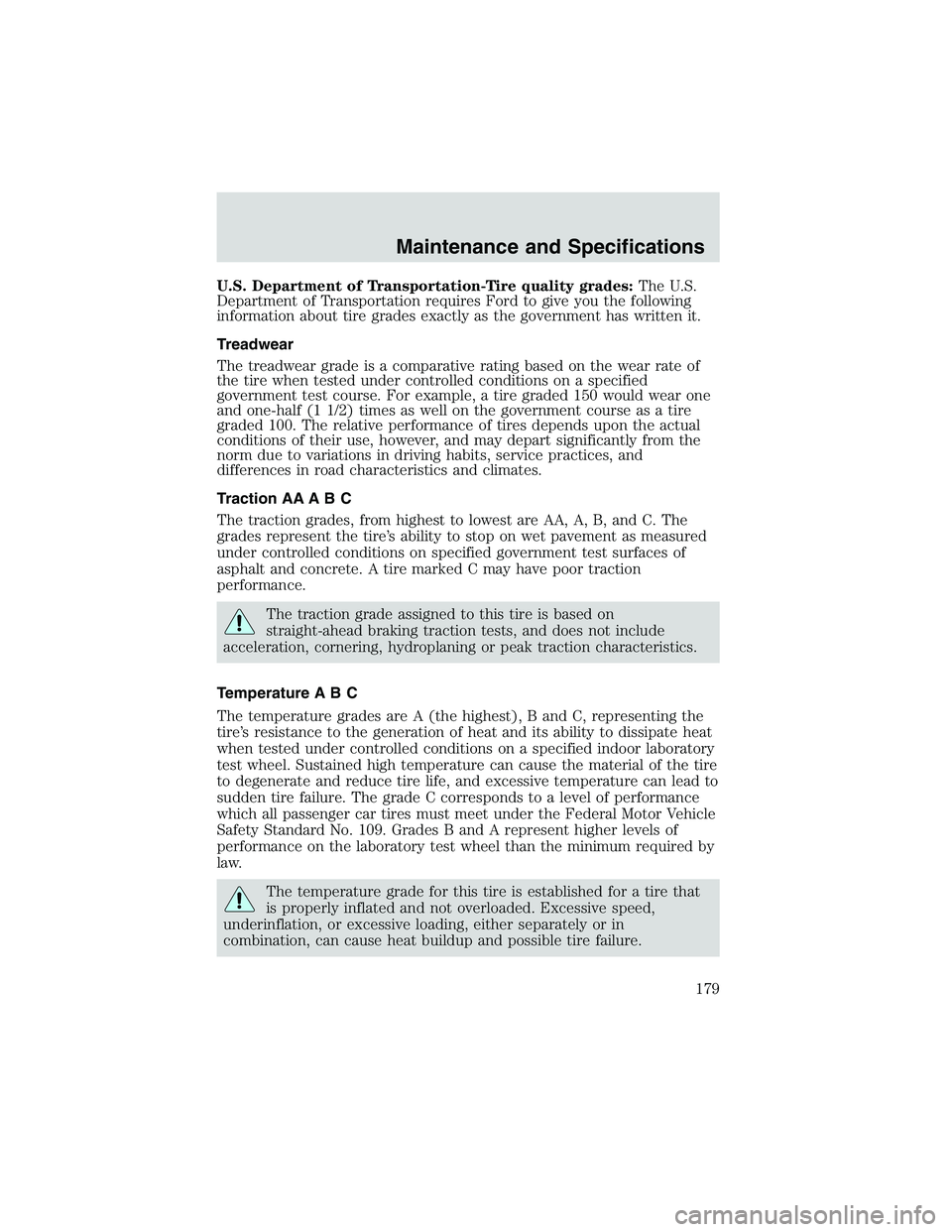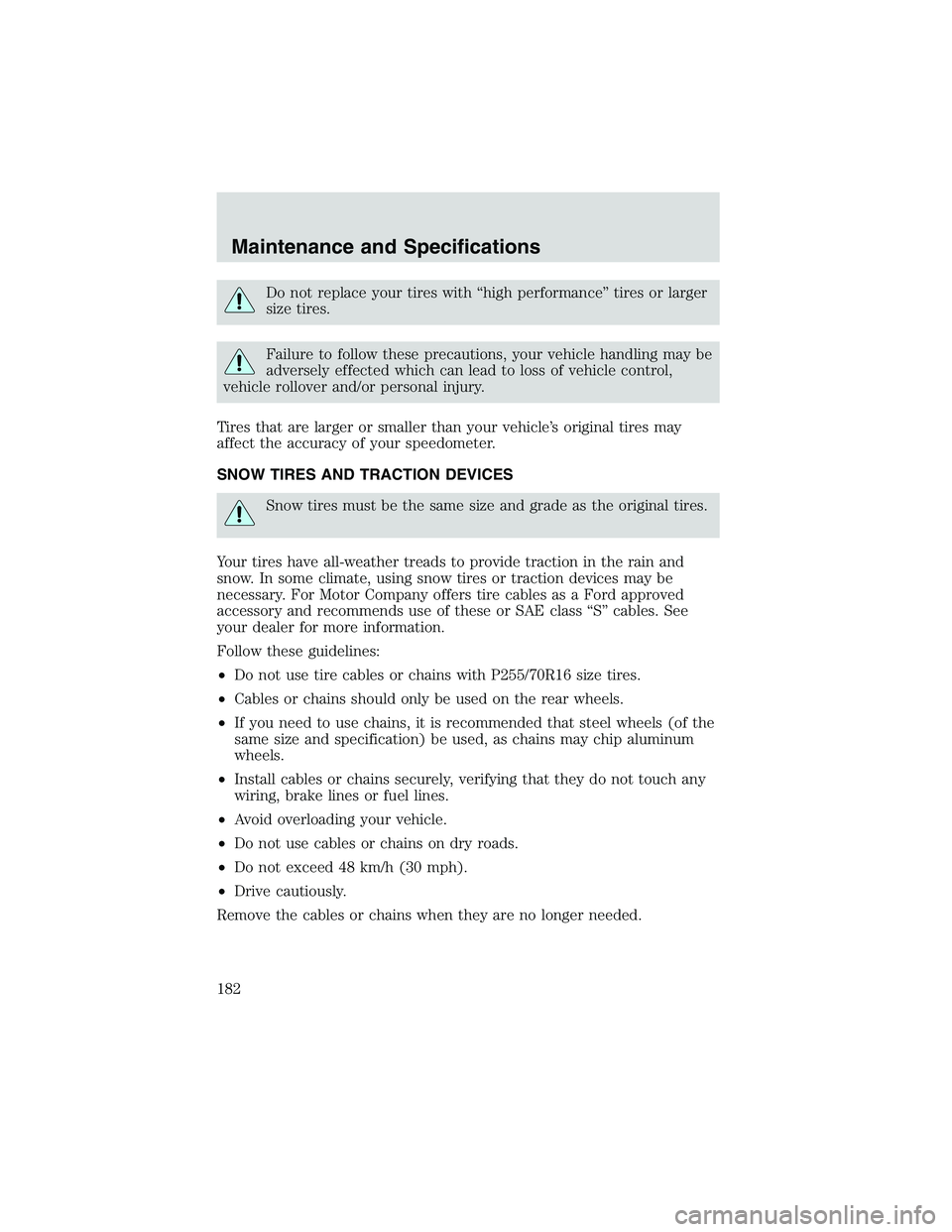2002 FORD EXPLORER SPORT TRAC traction control
[x] Cancel search: traction controlPage 6 of 200

These are some of the symbols you may see on your vehicle.
Vehicle Symbol Glossary
Safety Alert
See Owner’s Guide
Fasten Safety BeltAir Bag-Front
Air Bag-SideChild Seat
Child Seat Installation
WarningChild Seat Tether
Anchor
Brake SystemAnti-Lock Brake System
Brake Fluid -
Non-Petroleum BasedTraction Control
AdvanceTracMaster Lighting Switch
Hazard Warning FlasherFog Lamps-Front
Fuse CompartmentFuel Pump Reset
Windshield Wash/WipeWindshield
Defrost/Demist
Rear Window
Defrost/DemistPower Windows
Front/Rear
Introduction
6
Page 105 of 200

If the power steering system breaks down (or if the engine is turned
off), you can steer the vehicle manually, but it takes more effort.
If the steering wanders or pulls, check for:
•an underinflated tire
•uneven tire wear
•loose or worn suspension components
•loose or worn steering components
•improper steering alignment
TRACTION-LOK AXLE (IF EQUIPPED)
This axle provides added traction on slippery surfaces, particularly when
one wheel is on a poor traction surface. Under normal conditions, the
Traction-Lok axle functions like a standard rear axle.
To reduce the risk of injury, never run the engine with one wheel
off the ground, such as when changing a tire.
PREPARING TO DRIVE YOUR VEHICLE
Utility vehicles have a significantly higher rollover rate than
other types of vehicles.
In a rollover crash, an unbelted person is significantly more likely
to die than a person wearing a safety belt.
Your vehicle has larger tires and increased ground clearance, giving the
vehicle a higher center of gravity than a passenger car.
Vehicles with a higher center of gravity such as utility and
four-wheel drive vehicles handle differently than vehicles with a
lower center of gravity. Utility and four-wheel drive vehicles arenot
designed for cornering at speeds as high as passenger cars any more
than low-slung sports cars are designed to perform satisfactorily under
off-road conditions. Avoid sharp turns, excessive speed and abrupt
maneuvers in these vehicles. Failure to drive cautiously could result in
an increased risk of loss of vehicle control, vehicle rollover, personal
injury and death.
Driving
105
Page 114 of 200

If you must drive through high
water, drive slowly. Traction or
braking ability may be reduced.
Also, if the ignition system gets wet,
the vehicle may stall.
Once you’re through the water, always dry the brakes by moving your
vehicle slowly while applying light pressure on the brake pedal. Wet
brakes do not stop the vehicle as quickly as dry brakes.
When driving through mud, be cautious of sudden changes in vehicle
speed or direction. Even 4WD vehicles can lose traction in slick mud.
Apply the accelerator slowly and avoid spinning your wheels. If the
vehicle does slide, steer in the direction of the slide until you regain
control of the vehicle. If the transmission, transfer case or either axle
become submerged in mud or water, their fluids should be checked and
changed, if necessary. After driving through mud, clean off residue stuck
to rotating driveshafts and tires. Excess mud stuck on tires and rotating
driveshafts could damage driveline components.
“Tread Lightly”is an educational
program designed to increase public
awareness of land-use regulations
and responsibilities in our nations
wilderness areas. Ford joins the U.S.
Forest Service and the Bureau of Land Management in encouraging you
to help preserve our national forest and other public and private lands by
“treading lightly.”
Driving on hilly or sloping terrain
Avoid driving crosswise or turning on steep slopes or hills. Your vehicle
may lose traction and slip sideways and possibly roll over. Do not drive
in reverse over a hill without the aid of an observer.
Driving
114
Page 116 of 200

Brakessection of this chapter for additional information on the
operation of the anti-lock brake system. If your vehicle is not equipped
with ABS, use a“squeeze”braking technique. Push on the brake pedal
with a steadily increasing force which allows the wheels to brake yet
continue to roll so that you may steer in the direction you want to travel.
If you lock the wheels, release the brake pedal and repeat the squeeze
technique.
Never drive with chains on the front tires of 4WD vehicles without also
putting them on the rear tires. This could cause the rear to slide and
swing around during braking.
Maintenance and Modifications
Ford strongly recommends that you do not add or removing steering or
suspension parts (such as lift kits or stabilizer bars) or by using
replacement parts not equivalent to the original factory equipment. Do
not use aftermarket“lift kits”or other suspension modifications. These
could adversely affect the vehicle’s handling characteristics, which could
lead to loss of vehicle control or roll over and serious injury. Frequent
inspection of vehicle chassis components is recommended if the vehicle
is subjected to heavy off-road usage.
DRIVING THROUGH WATER
If driving through deep or standing water is unavoidable, proceed very
slowly especially if the depth is not known. Never drive through water
that is higher than the bottom of the hubs (for trucks) or the bottom of
the wheel rims (for cars). Traction or brake capability may be limited
and your vehicle may stall. Water may also enter your engine’s air intake
and severely damage your engine.
Once through the water, always dry the brakes by moving your vehicle
slowly while applying light pressure on the brake pedal. Wet brakes do
not stop the vehicle as quickly as dry brakes.Driving through deep
water where the transmission vent tube is submerged may allow
water into the transmission and cause internal transmission
damage.
VEHICLE LOADING
Before loading a vehicle, familiarize yourself with the following terms:
•Base Curb Weight:Weight of the vehicle including any standard
equipment, fluids, lubricants, etc. It does not include occupants or
aftermarket equipment.
•Payload:Combined maximum allowable weight of cargo, occupants
and optional equipment. The payload equals the gross vehicle weight
rating minus base curb weight.
Driving
116
Page 179 of 200

U.S. Department of Transportation-Tire quality grades:The U.S.
Department of Transportation requires Ford to give you the following
information about tire grades exactly as the government has written it.
Treadwear
The treadwear grade is a comparative rating based on the wear rate of
the tire when tested under controlled conditions on a specified
government test course. For example, a tire graded 150 would wear one
and one-half (1 1/2) times as well on the government course as a tire
graded 100. The relative performance of tires depends upon the actual
conditions of their use, however, and may depart significantly from the
norm due to variations in driving habits, service practices, and
differences in road characteristics and climates.
Traction AA A B C
The traction grades, from highest to lowest are AA, A, B, and C. The
grades represent the tire’s ability to stop on wet pavement as measured
under controlled conditions on specified government test surfaces of
asphalt and concrete. A tire marked C may have poor traction
performance.
The traction grade assigned to this tire is based on
straight-ahead braking traction tests, and does not include
acceleration, cornering, hydroplaning or peak traction characteristics.
Temperature A B C
The temperature grades are A (the highest), B and C, representing the
tire’s resistance to the generation of heat and its ability to dissipate heat
when tested under controlled conditions on a specified indoor laboratory
test wheel. Sustained high temperature can cause the material of the tire
to degenerate and reduce tire life, and excessive temperature can lead to
sudden tire failure. The grade C corresponds to a level of performance
which all passenger car tires must meet under the Federal Motor Vehicle
Safety Standard No. 109. Grades B and A represent higher levels of
performance on the laboratory test wheel than the minimum required by
law.
The temperature grade for this tire is established for a tire that
is properly inflated and not overloaded. Excessive speed,
underinflation, or excessive loading, either separately or in
combination, can cause heat buildup and possible tire failure.
Maintenance and Specifications
179
Page 182 of 200

Do not replace your tires with“high performance”tires or larger
size tires.
Failure to follow these precautions, your vehicle handling may be
adversely effected which can lead to loss of vehicle control,
vehicle rollover and/or personal injury.
Tires that are larger or smaller than your vehicle’s original tires may
affect the accuracy of your speedometer.
SNOW TIRES AND TRACTION DEVICES
Snow tires must be the same size and grade as the original tires.
Your tires have all-weather treads to provide traction in the rain and
snow. In some climate, using snow tires or traction devices may be
necessary. For Motor Company offers tire cables as a Ford approved
accessory and recommends use of these or SAE class“S”cables. See
your dealer for more information.
Follow these guidelines:
•Do not use tire cables or chains with P255/70R16 size tires.
•Cables or chains should only be used on the rear wheels.
•If you need to use chains, it is recommended that steel wheels (of the
same size and specification) be used, as chains may chip aluminum
wheels.
•Install cables or chains securely, verifying that they do not touch any
wiring, brake lines or fuel lines.
•Avoid overloading your vehicle.
•Do not use cables or chains on dry roads.
•Do not exceed 48 km/h (30 mph).
•Drive cautiously.
Remove the cables or chains when they are no longer needed.
Maintenance and Specifications
182
Page 194 of 200

A
Air bag supplemental restraint
system ....................................83–84
and child safety seats ..............85
description ................................84
disposal ......................................87
driver air bag ............................86
indicator light ...........................87
operation ...................................86
passenger air bag .....................86
Air cleaner filter .......................183
Anti-lock brake system
(see Brakes) ......................103–104
Audio system (see Radio) ...14, 27
Automatic transmission
driving an automatic
overdrive .................................107
fluid, refill capacities ..............183
fluid, specification ..................188
Auxiliary power point .................44
Axle
lubricant specifications ..186, 188
refill capacities ........................183
traction lok ..............................105
B
Battery
replacement, specifications ...183
BeltMinder ...................................79
Brakes ........................................103
anti-lock ...........................103–104
anti-lock brake system (ABS)
warning light ...........................103
fluid, refill capacities ..............183
fluid, specifications .........186, 188
lubricant specifications ..186, 188
parking ....................................104
shift interlock ..........................106C
Capacities for refilling fluids ....183
Cargo cage ...................................55
Cassette tape player ...................27
CD-single premium .....................14
Certification Label ....................190
Child safety restraints ................88
child safety belts ......................88
Child safety seats ........................91
attaching with tether straps ....96
in front seat ..............................92
in rear seat ..........................92, 95
Cleaning your vehicle
engine compartment ..............154
instrument panel ....................156
interior .....................................156
plastic parts ............................155
washing ....................................153
waxing .....................................153
wheels ......................................154
wiper blades ............................155
woodtone trim ........................156
Clock ............................................27
Clutch
operation while driving ..........109
recommended shift speeds ....109
Compass/temperature display ...52
Console ........................................42
floor ...........................................42
overhead ....................................42
Controls
power seat .................................69
Coolant
refill capacities ........................183
specifications ..................186, 188
Customer Assistance ................125
Index
194
Page 197 of 200

S
Safety belts (see Safety
restraints) ..............................73–77
Safety defects, reporting ..........152
Safety restraints ....................73–77
belt minder ...............................79
cleaning the safety belts ..........82
extension assembly ..................82
for adults .............................74–76
for children .........................87–88
lap belt ......................................78
warning light and chime ..........78
Safety seats for children ............91
Seat belts (see Safety
restraints) ....................................73
Seats ............................................68
child safety seats ......................91
Spare tire (see Changing the
Tire) ...........................................135
Spark plugs,
specifications .....................183, 188
Specification chart,
lubricants ...........................186, 188
Speed control ..............................49
Starting your vehicle ..99–100, 102
Steering wheel
tilting .........................................42
T
Tailgate ..................................54–55
Tires ...................................178–179
changing ..................................135tire grades ...............................179
treadwear ................................179
Tonneau cover .............................57
Towing .......................................118
recreational towing .................123
trailer towing ..........................118
Traction-lok rear axle ...............105
Transmission .............................106
fluid, checking and adding
(manual) .................................177
fluid, refill capacities ..............183
lubricant specifications ..186, 188
manual operation ....................109
Trunk ...........................................59
Turn signal ..................................36
V
Vehicle dimensions ...................188
Vehicle Identification Number
(VIN) ..........................................190
Vehicle loading ..........................116
camper bodies ........................123
Ventilating your vehicle ...........103
W
Warning lights (see Lights) .........8
Water, Driving through .............116
Windows
power .........................................45
power down back window .......46
Windshield washer fluid and
wipers ..........................................41
replacing wiper blades .............41
Index
197